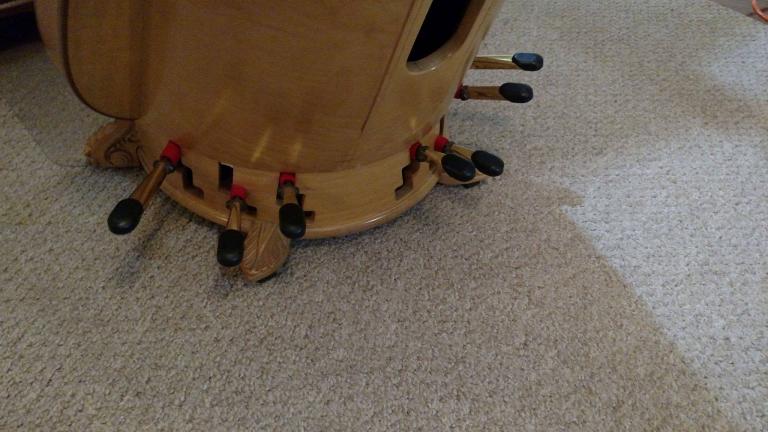
The styles range from gothic to art deco. Both companies produced ornately carved and sometimes gilded harps for their clientele. Wurlitzer made harps for a few decades but ceased by the 1930s. This fueled a great growth in music for the harp in the 20th century, and the concert careers of many virtuosi. These improvements inspired harpists and composers to seek new sounds and music to express its fuller resonance. They improved the construction and resulting sound, in part to withstand the rigors of the American climate.

became the major manufacturer of pedal harps in America by the end of the 19th century.

of the 20th century resulted in its spread into popular music”. The greatest influence on use of the harp has always been the availability of fine harps and skilled players, and the great increase of them in the U.S. Tchaikovsky also was of great influence, followed by Rimsky-Korsakov, Richard Strauss and Wagner. Debussy can be said to have put the harp on the map in his many works that use one or more harps. In opera, the Italian composers used it regularly, and Puccini was a particular master of its expressive and coloristic use. French and Russian Romantic composers particularly expanded its symphonic use. Franz Liszt was seminal in finding uses for the harp in his orchestral music, and Mendelssohn and Schubert used it in theatrical music or oratorios. It began to be used in symphonic music by Hector Berlioz but he found performances frustrating in such countries as Germany where qualified harpists and harps were few to be found. Bach, Mozart, Albrechtsberger, Schenck, Dussek, Spohr) and in the opera houses of London, Paris and Berlin and most other capitals. “The harp found its early orchestral use in concerti by many baroque and classical composers (Handel, J. Early Pedal Harp (1791) Museum of châlons-en-Champagne (51) France. While played initially in salons, the pedal harp soon progressed to the concert hall in the nineteenth century and began to be studied seriously by musicians in harp schools established in major European cities. This music, now called “classical”, is the primary type of music associated with the pedal harp as it is played in contemporary concert settings. Composers throughout Europe began to write music aimed at taking advantage of the technological innovation of the pedal harp. The pedal harp began to be introduced throughout Europe, finding it’s greatest popularity in Paris, where the manufacture of the instrument achieved further refinement. “By 1720 the number of pedals was increased to seven, one for each note in the diatonic scale”.
MAINSTAGE 3 SET HARP PEDALS PATCH
And seamless Patch switching lets you hold a chord in one sound while moving to a new Patch.The pedal for the harp was first developed in the late 1690s/early 1700s as a mechanism to link the hooks on a hook harp to pedals (hooks were a precursor to levers on non-pedal harps, turned to change the pitch of a string). With Multimapping, you can map multiple parameters to a single control, so you can smoothly manipulate your sound without trying to turn several knobs at once. Start walking a bassline up the keyboard, and the split point moves up so the bass doesn’t suddenly become some other sound when you get into the higher notes. It intelligently moves the split point on a split keyboard Patch to respond to what you’re playing. For starters, there’s the Floating Split Point.
MAINSTAGE 3 SET HARP PEDALS SOFTWARE
MainStage is not only an amazing host for software instruments and effects, it’s also packed with innovations that let you shine on stage. Or bring the authentic sounds of a Hammond B3 organ, Hohner Clavinet D6, or Fender Rhodes or Wurlitzer electric pianos on stage. Use Retro Synth to recreate your favourite electronic sounds from the ’70s and ’80s with an intuitive set of controls. And Chord Trigger allows you to press a single note and have it trigger an entire complex chord. The Arpeggiator features note-based remote controls and flexible latch modes.

Take your performance beyond what you can actually perform.


 0 kommentar(er)
0 kommentar(er)
